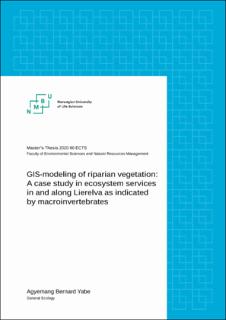| dc.description.abstract | Lierelva is a river located in SE-Norway in Auskog-Holand municipality. It has a large drainage area and joins Lake Bjorkelangen in the south.
This study has two major purposes: (1) determine the various types of riparian vegetation along Lierelva using ArcGis; (2) explore how ecosystem services and ecological relationships of riparian vegetation affect River Lierelva and the surrounding communities based on macroinvertebrates. Additionally, information on land-uses and management practices was discussed. The macroinvertebrates that were obtained were analyzed in terms of diversity, abundance, distribution and richness.
In the first of the thesis, general information about riparian vegetation, ecosystem services and anthropogenic impacts/threats are represented. The data derived of GIS modelling were systemized and presented. The data showed that four main CORINE classes of riparian vegetation (arable land, pasture, forest and urban fabric) surround Lierelva. A worrying trending of conversion of intact forests to other land-uses was evident from the data. Based on data from the analysis of macroinvertebrates, high figures for species abundance, species richness, species diversity and ASPT Index were detected in samples close to intact forests. On the contrary, relatively low figures were recorded for samples close to agricultural, pasture land-uses and urban fabric. This trend is attributed to the ecosystem services such as erosion prevention, water purification, temperature regulation etc. provided by intact forests. Finally, the results obtained were interpreted in the discussion part regarding how surrounding communities benefit from these ecosystem system services. Also, a comparison of the average ASPT Index with water quality chart/tables was done to determine the overall water quality of Lierelva.
It was concluded that, Lierelva has reasonable amount of riparian vegetation along its banks and that their presence is vital to the river ecosystem and the surrounding communities. The water column remains unpolluted and the river ecosystem is not suffering from the negative effects of degradation of riparian vegetation yet. The major sources of organic and inorganic pollution are anthropogenic, sedimentation and nutrient deposition, which will all increase at the current rate of forestlands conversion. Enactment of good policies coupled with strong stakeholder involvement can help stop their degradation. | en_US |

